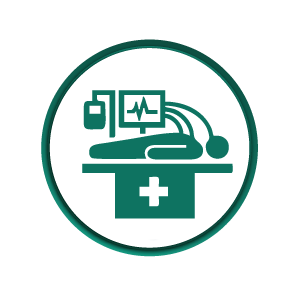Departments
ANAESTHESIOLOGY
We use multiple strategies to increase quality and improve patient outcomes. Our patients eat, drink and get out of bed after surgery more quickly than is typical at other medical centers.
They experience shorter hospital stays, faster recoveries and report higher levels of satisfaction.
Through our Preoperative Evaluation and Planning Center (PEPC), we ensure that each patient is ready for surgery. We use multiple tools to optimize your health before operating. Your care might involve physical therapy before surgery, chronic pain management or improving your diet and exercise. Research has shown that preoperative planning and health optimization significantly reduces your recovery time after surgery.
All of our anesthesiologists many of them have subspecialty fellowship training. For example, we have specialists in cardiac, pediatric, obstetric, neuro anesthesia, as well as pain medicine specialists.
Thanks to our subspecialty anesthesiologists, we offer a full range of anesthesia and perioperative treatments (pain control before, during and after surgery). From acute pain management to postoperative care, our specialists are ready to help. Our areas of care include
We provide both pharmacologic and non-pharmacologic pain management during labor and delivery, including epidurals labour analyesis our anesthesiologists provide expert obstetric anesthesiology and support each mother’s preferences for pain management.
Pain medicine
Acute pain and regional anesthesiology: If you have pain from an injury or after surgery, our acute pain service is available 24/7. We use a multifaceted approach to pain management that includes optimized nutrition, movement and nonsteroidal anti-inflammatory drugs (NSAIDs). Using these strategies improves outcomes and relieves pain while minimizing the use of opioids.
In partnership with the specialists at TENDER PALM HOSPITAL, we deliver anesthesialogy to newborns, infants and children. We work closely with other pediatric subspecialties to minimize pain during therapeutic and diagnostic procedures, as well as assist in the operating rooms.
Our anesthesiologists use a variety of techniques to help you recover from surgery more quickly without using narcotics. Areas of surgical anesthesia include:
Inpatient surgery: Inpatient surgeries include an overnight stay in the hospital. For example, most heart and brain surgeries are inpatient operations. We use anesthesia techniques that manage pain while allowing you to recover and return home quickly.
Outpatient surgery: When you have an outpatient operation, you return home the same day of surgery. For outpatient surgeries, we often use anesthesia techniques that don’t put you fully to sleep. These types of anesthesia allow you to return home more quickly after an operation.
Preoperative Evaluation and Planning Center (PAC): Before surgery, patients visit the PAC either in person or through a telemedicine visit. The goal of the PAC is to optimize a patient’s health before surgery. Not only does this optimization lead to better outcomes, but it also helps ensure better pain relief and control.
Post-Anesthesia Care Unit: We use multiple options such as epidural anesthesia, peripheral nerve blocks and intravenous medications to manage postsurgical pain in the hospital. We coordinate with specialists on the chronic pain team to smoothly transition patients to outpatient pain management as necessary.
Conditions anesthesiologists treat
We work closely with multiple specialists to care for specific conditions. We provide specialized anesthesiology support for:
Cardiothoracic surgery: We provide services cardiac surgery patients interventional cardiology and electrophysiology patients. As active researchers, we are continually finding new and better treatment options to control surgical pain.
Ophthalmologic surgery: Ophthalmology surgery patients each year. We manage anesthesia for patients undergoing cataract surgery, corneal transplants, retina surgery and more. We also provide anesthesia for infants and children undergoing eye surgery.
Thoracic surgery: Our anesthesiologists work alongside the thoracic surgery team to provide care to patients participating in thoracic (chest) surgeries each year. We are one of only a few centers where patients can receive specialized surgery for mesothelioma, called the surgical pleurectomy and decortication. This procedure preserves more lung tissue and has better outcome rates than other standard treatment options.
Transplantation surgery: Many of the programs in our Transplantation Services are among the best in the country.
Vascular surgery: Vascular surgeons treat conditions that affect the veins and blood vessels. In partnership with the Vascular Surgery team, we care for more than 1,000 vascular patients each year. Thanks to expanding technology, we can often use sedation to deliver quality care while improving patient outcomes.
Treatments anesthesiologists offer
We use multiple techniques to manage pain. Typically, the goal of anesthesia is to provide pain control before, during and after surgery. Common types of anesthesia include:
Local anesthesia: This technique uses a small injection of a numbing medication, such as lidocaine. We often use local anesthesia for outpatient surgeries or during dental procedures.
Regional anesthesia: This approach blocks sensations to just one part of the body. One of the most common types of regional anesthesia is an epidural, which is often used during childbirth. Regional anesthesia also includes nerve blocks, which numb certain clusters of nerves. If you are having surgery on your leg or arm, for example, you may have a femoral nerve block or a brachial plexus block.
Sedation: Sometimes called monitored anesthesia care, sedation is what many people know as “twilight sleep.” With this type of anesthesia, you typically receive intravenous (IV) medication that helps you relax and feel drowsy. You may have mild sedation, where you can still respond to questions. Or you may have deep sedation, meaning you are deeply asleep but can still breathe without assistance.
General anesthesia: You may receive general anesthesia through an IV, breathing tube or mask. When you are under general anesthesia, you are unconscious and can’t feel any sensations. If you have general anesthesia during surgery, you may feel extreme drowsiness for a few hours after the operation.
Multi- modal anesthesia –use more than one tech for better patient out come.



